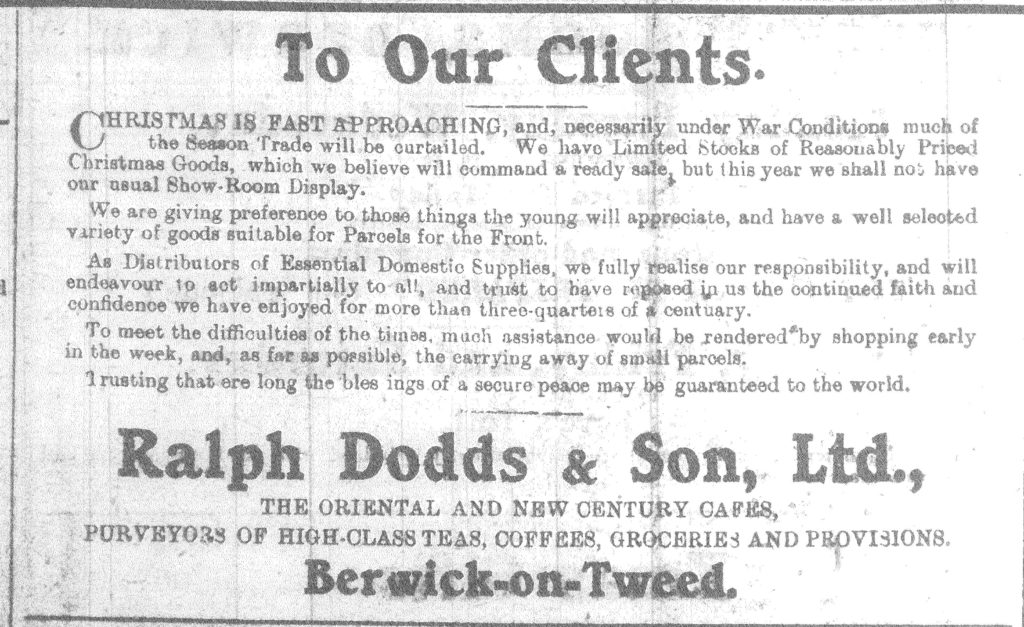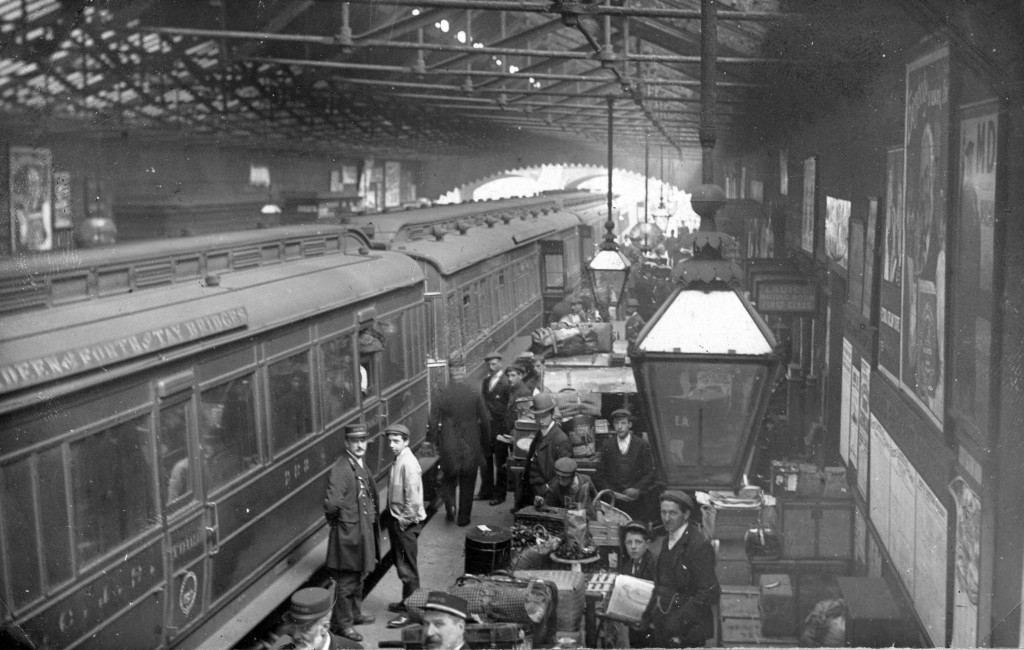DEVELOPMENT OF BERWICK
The second article in the “Edinburgh Evening News” dealing with Berwick was as followed:- Linked up with the development project previously outlined there is another scheme which the unemployment emergency may force into speedy practical operation. Local authorities everywhere are finding great difficulty in providing work for the unemployed, the cost of which can be absorbed, in the largest possible proportion, in wages, but Berwick, although its unemployment problem is not so acute as in many places, could at once address itself to a work of improvement which meets that qualification. What is proposed is the levelling and laying out of a promenade on the low-lying sea cliffs which, extending within the borough for three miles from north to south, skirt the area that has been suggested for town-planning and continue for some distance on the Spittal side of the river.
This line of sea front, is uneven just now, but it has beautiful turf. There is at present only a narrow and ill-defined path, but a beautiful promenade could be made which would greatly enhance the attractiveness of the town. There is reason to believe that more will be heard of this proposal in the near future.
SCHEME OF RECONSTRUCTION
With regard to the houses which have been scheduled as unhealthy and call for reconstruction, it is proposed, if and when reconstruction takes place, that the first areas to be dealt with will be those from the ramparts between the Scotsgate and Wallace Green, and between High Street, Church Street, and the Town Hall.
Wallace Green should be hallowed ground for patriotic Scots. When Wallace was executed in 1305, one half of his body was ordered to be exposed on Berwick Bridge, and, according to tradition, his left arm was buried in the Wallace Green.
Berwick is justly proud of its Town Hall, which, dating from about 1755, has a tetrastyla Doric portico and a tower surmounted by a spire 150 feet high and occupies a commanding position at the foot of High Street, but the wit of man could not have conceived a more inconvenient situation for it. To make the bottom corners reasonably safe for traffic would entail carrying back the frontage on both sides of the street a very considerable extent.
Such a project could not be undertaken all at once. Building lines should, however, be laid down, and any rebuilding made to comply with them, so that the improvements could gradually take shape. It is from the spire of the Town Hall that the curfew bell rings at eight o’clock every evening, Berwick being one of the few remaining towns where this ancient custom is observed daily as a reminder of a bye-gone age is the existence of the old wooden stocks in a conspicuous place to the right of the Town Hall entrance.
THE SCOTSGATE
The original war memorial scheme having been dropped, the Scotsgate at the top of high Street has been given a fresh lease of life. The Scotsgate was once the most important of all the gates, and originally was in architectural harmony with the ramparts, of which it forms part, but the present structure has neither architectural nor antiquarian value.
A public improvement embodying a much needed widening of the road was proposed by the War Memorial Committee for the removal of the Scotsgate, and on the wall face which would require to have been built after the demolition, it was intended to place large bronze tablets depicting a naval and a military incident in the Great war, together with the names of the 450 gallant townsmen who fell. But a cry of “vandalism” was raised, and the scheme fell through.

Instead of one memorial for the whole borough, Tweedmouth and Spittal went forward with memorial of their own, and Berwick is now to have its memorial in the shape of a bronze figure of Victory on an open space in front of St. Mary’s Church in Castlegate.
INDUSTRIAL EXPANSION
Only a moderate shipping trade is now carried on at the harbour, but a case could be made out for Berwick greatly extending its harbour and vitalising its industrial activities.
Berwick is probably the nearest British port to the Baltic, and an important development of the timber trade suggests itself as the only one consequence of future harbour extension. Berwick is admirably situated to be a busy seaport and an inland distributing centre. Much of its present prosperity depends upon its service to the agricultural communities in Berwickshire and Northumberlandshire. As matters stand there is a considerable import of timber for the well-known saw mills at Tweedmouth.
Other local industries are connected with fishing and agriculture. There are important implement works in the town proper and a big manure facture at Spittal. The corn and cattle markets rank very high in the country, and before the war more barley was exported coastwise than from any other port in the Kingdom. Pride of place should probably be given to the fishing industry. The salmon fisheries have always been famous and the herring fishing with its attendant trades of curing, smoking, and coopering is carried on in the town on a large scale. This has unfortunately been a disastrous season for the herring fishery, and Spittal feels particularly sore about it, because improved accommodation for the fishing boats has only recently been provided.
INADEQUATE RAILWAY STATION
When one considers the importance of Berwick as a railway centre, its position as the terminus of the North British and North eastern systems and the splendid enterprise of the former company some 70 years ago in erecting the Royal Border bridge with its 28 noble arches, one is amazed to find the content with such a mean, inadequate, and squalid railway station. A new railway bridge outside the station has, however, just been completed, and it may be assumed that this is the first stage in the erection of a properly equipped station.
Berwick Station, although a poor affair, occupies a proud site, the ruins of the old Castle having been demolished to make way for it. Only a fragment remains of that famous fortress, the scene of grim battle and weighty council that decided much in Scottish history.

Ref: BA/W/6
The present booking office stands on the site of what was the great hall of Berwick castle in which Edward I assembled the gathering of nobles which decided as between Bruce and Baliol for the Scottish Crown. The same English King has a sinister connection with the Castle by having shut up for four years in a wicker basket with its walls the Countess of Buchan for placing the Crown upon the head of Bruce at Scone.
THE ANCIENT WALLS
Upon whatever lines Berwick of the future chooses to develop it will for ever possess peculiar charm as one of the few walled towns that remain in Great Britain. Only scant relics exist of the Edwardian walls, but the earth-works of the Elizabethan Walls, now converted into a well-appointed grass-banked promenade, encircle the old town for about a mile and a half, and afford land and sea views of rare beauty and interest.
For all their romantic charm the Walls have seriously contributed to the congestion of buildings and hindered expansion, and for proper expansion it would be necessary to make openings through them without obstructive archways. No one dreams of destroying the Walls, but to cut a slice here and there would open out the town and would not obscure the fact that they were once continuous. From the Walls many interesting landmarks of the town can best be viewed, including two places which this year are entitled to centenary notice. Berwick barracks have now reached the 200th year of their age.
The other place of centenary interest is the Pier, which was completed in 1821. It is about half a mile length, and is one of the favourite walks of the townspeople, who have peculiar affection for their lighthouse, a noble building on the end of their Pier, dating from 1826.
Berwick stretches its burghal sphere of influence to the south side of the Tweed to embrace Tweedmouth and Spittal. Access to Spittal is obtained by a ferry, the landing stage of which might with great advantage be made more convenient for the public.
The southern suburbs of Tweedmouth and Spittal, the latter enjoying much popularity as a holiday resort, displaying those wholesome pro-pressive tendencies which, in an increasing degree are today characteristic of the whole borough. A new atmosphere is being created in Berwick, and while little can be done immediately, the spirit of progress has awakened, and in due course will make itself felt.











